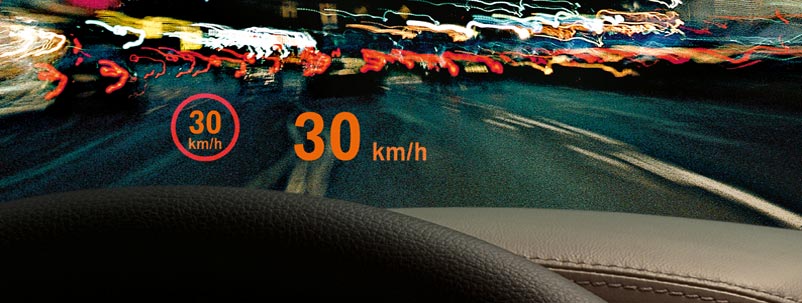Navigation Company, Garmin recently announced they will be releasing a Head-up Display (HUD), that will project navigation information from a user’s smartphone onto the windshield. The Garmin HUD will display real-time traffic and directions on either a transparent film, mounted on the wind shield or a reflector lens on the HUD cradle. The information on the Garmin StreetPilot1 or Navigation app will appear in the windshield.
Navigation Company, Garmin recently announced they will be releasing a Head-up Display (HUD), that will project navigation information from a user’s smartphone onto the windshield. The Garmin HUD will display real-time traffic and directions on either a transparent film, mounted on the wind shield or a reflector lens on the HUD cradle. The information on the Garmin StreetPilot1 or Navigation app will appear in the windshield.
Increasingly, technology is working its way into automobiles; high end devices like HUD displays have been is fighter jets, and options in high-end automobiles for years. Now they are becoming available outside the luxury market.
What makes HUD different is the price, just $129 for the phone cradle. It used to be an option that ran up to over $1000 in luxury cars.
One of the main advantages if these displays with that they allow users to get direction from their smartphone without taking their eyes away front the road, says Dan Bartel, Garmin VP of Sales.
The belief is drivers using Head-Up Devices be paying attention, as much as they would be if they were not using the device at all? Garmin claims on their website “By providing comprehensive road guidance at a glance and right within the driver’s line of sight, HUD can help increase safety and reduce driver distraction.”
But will drivers be watching the display or the road? A 1995 study from the National Highway Traffic Safety Administration found that HUDs could benefit older drivers, there were still issues, including “visual clutter” from the display the risk of headaches and eye fatigue for the driver . However, this study is nearly 20 years old and, so technology may have improved some of these safety issues.
Certainly, HUDS will decrease distraction for people who are driving on an unfamiliar route. And watching the road is not the same as paying attention.
Distracted driving is at a rise and even hands free devices and voice activated systems have the same accident risk as driving while intoxicated. The issue is drivers are not watching the road, paying attention, and focusing on other cars and pedestrians.
Clearly, just because a device does not require you to take your eyes off the road, it does not mean you will automatically be safer.
Another interesting feature will alert drivers if they exceed the speed limit, but that one will probably be turned off the most is it is optional.
As Internet advertisers and social media agencies have learned, people love to take their technology with them, even when they are driving. Texting, talking on the phone, and looking at navigation systems lead to serious accidents every year. The safest feature of the HUD may be that it keep phones busy and out of the hands of drivers.
For information about web design services, please contact fishbat Web Design Long Island NY.

